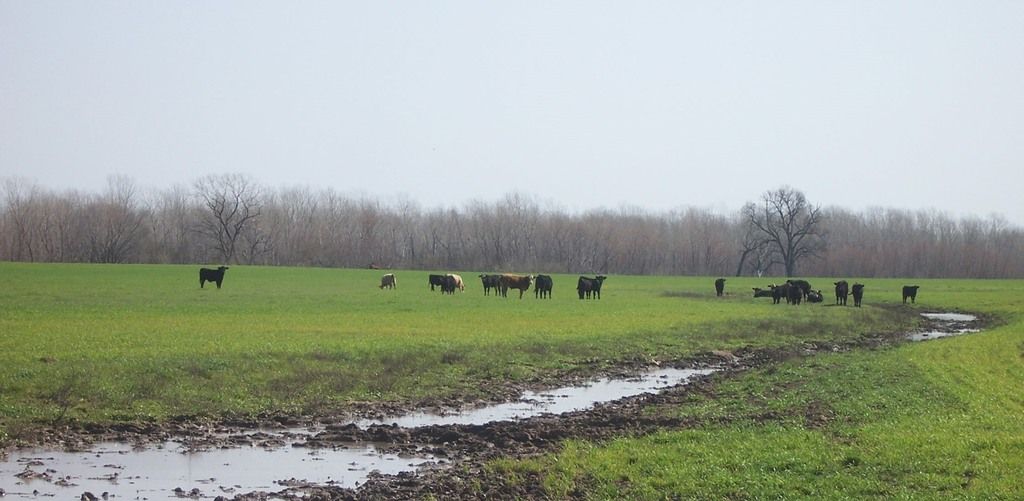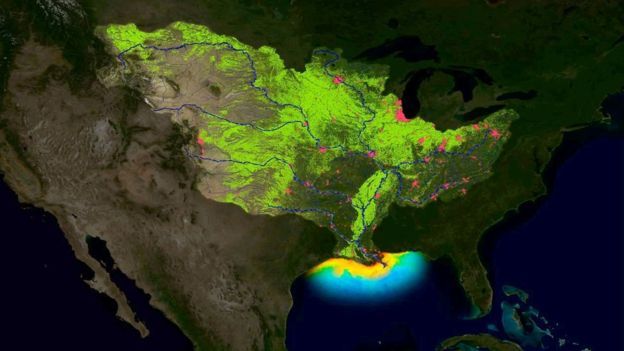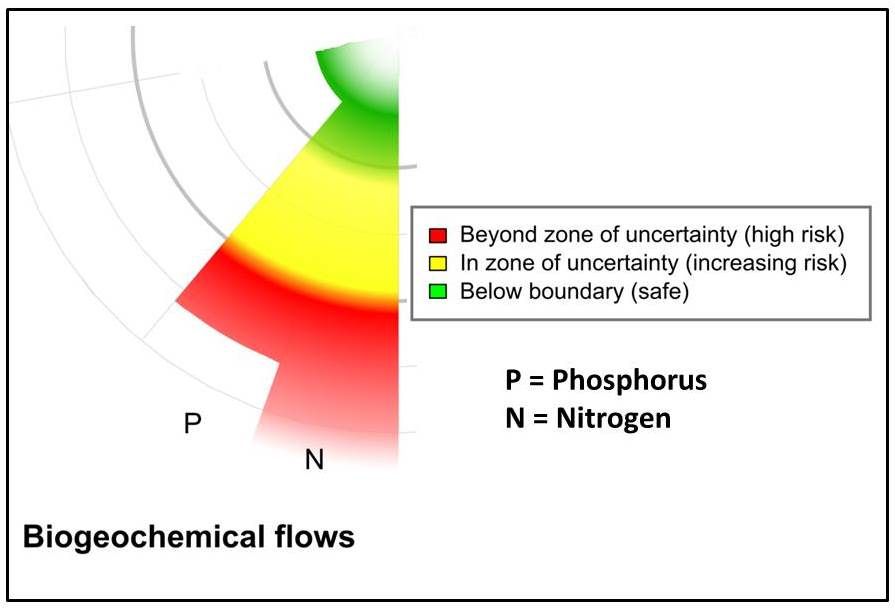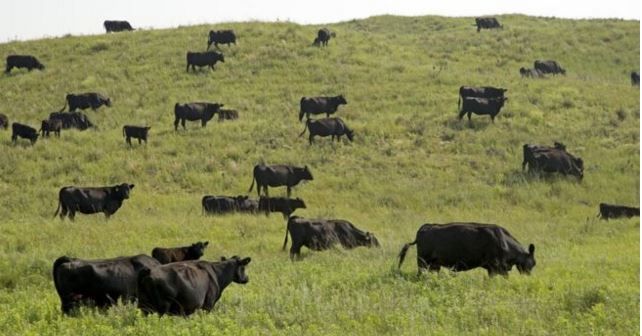Ever-Growing Human Demands Stress Biosphere: The Case of Fertilizers, Livestock Production and Dead Zones
Published on March 5th, 2016
The BBC reports that a recent scientific study in the journal Nature Communications indicates that global food production requires a “significant” boost in fertilizer use to meet exponentially rising demands from population growth and more meat-and-dairy intensive diets.
Yet this call comes at the same time other scientists have found that biogeochemical flows of nitrogen and phosphorus from excessive fertilizer use have already transgressed “planetary boundaries.”
 |
|
Cattle grazing on manmade grassland in northeast Texas. The natural vegetation in this
biome is the woodland visible behind, to which this pasture would revert if grazing
and mowing were to cease. However, naturally occurring grasslands, such as prairies,
rangelands and steppes, are also abundant around the world.
|
The Nature Communications study – “Negative global phosphorus budgets challenge sustainable intensification of grasslands” – observes that global food demand is projected to skyrocket in the approaching decades. This is particularly true for those staples of middle-class diets – meat and milk – and especially in fast-growing developing nations.
Grasslands occupy 26 percent of the Earth’s ice-free land area, or 3.3 billion hectares (8.2 billion acres or 12.7 million square miles). They contribute to global food production by furnishing proteins and energy to ruminants like cattle and sheep.
The worldwide area of grasslands grew by 4 percent from 1970 to 2005, mostly as a result of deforestation, or conversion of forests and woodlands to pastures and grasslands. However, degradation of grasslands is expected to accelerate in the future because of overgrazing and resulting soil erosion, nutrient deficiencies, weed invasions and desertification.
Meeting global food demand in a sustainable manner is one of the greatest challenges facing humanity in the 21st century.
The nutrient phosphorus is a major issue both because of its finite reserves and because it is a limiting nutrient in agriculture. Phosphorus is an essential element for all living organisms, both plants and animals. Yet it is only since the 19th century that humans began to systematically use it and other nutrients to boost agricultural production.
 |
|
Harmful algal bloom and dead fish.
Credit: Dr. Jennifer L. Graham, U.S. Geological Survey |
According to Charles C. Mann’s fascinating book, 1493: Uncovering the New World Columbus Created, the mass exploitation of guano for fertilizer began in the 1800s. Guano, or dried seabird excrement, contains exceptionally high concentrations of three essential elements: nitrogen, phosphorus and potassium. According to Mann, the mass export of guano from the coast of Peru, “was the beginning of today’s input-intensive agriculture – the practice of transferring huge amounts of crop nutrients from one place to another, distant place….”
Phosphorus is also a major issue in water pollution. The two nutrients phosphorus and nitrogen are responsible for red tides and algal blooms (uncontrolled growth of algae) which cause oxygen depletion, fish kills and “dead zones.” One such dead zone occurs every summer in the Gulf of Mexico at the mouth of the Mississippi River.
 |
|
Runoff of the fertilizers/nutrients phosphorus and nitrogen from agricultural lands can create dead zones like this one at the mouth of the Mississippi River in the Gulf of Mexico. It forms every summer and results from severe oxygen depletion (anoxia) due to nutrient-fed algae blooms.
|
Phosphorus is removed from grassland when grass is eaten by livestock, which are themselves then removed when they are taken away to be slaughtered and fed to humans. Erosion and runoff also remove phosphorus from grassland soils. Because weathering of underlying rock to create soil is so slow, the lost phosphorus must be replaced through organic (mostly manure) and mineral fertilizer inputs.
Authors of the Nature Communications study found that more phosphorus is being lost from soils than is being added by manure and fertilizers applied by farmers and ranchers. They state that to meet the projected demand for meat and grassland by 2050, the amount of phosphorus used will have to increase four times from 2005 levels.
“It is our strong assumption that productivity will decrease and the pressure on our feed crops will increase,” co-author Martin van Ittersum from the University of Wageningen in the Netherlands told the BBC. Hence, the need for greater application of phosphorus fertilizer.
But as the BBC points out, and as mentioned above, increasing phosphorus use on agricultural land raises serious environmental concerns. Leaching of phosphorus from these lands into rivers, lakes and eventually the ocean leads to algal blooms and dead zones like those found in Lake Erie, the Gulf of Mexico and the Baltic Sea. One can only imagine the deleterious effects of a four-fold increase in the use of phosphorus.
An international team of scientists associated with the Stockholm Resilience Centre in Sweden has developed a list of “planetary boundaries” that human civilization must not transgress if we are going to be good tenants – and stewards – of Planet Earth. One of these boundaries is for “biogeochemical flows,” that is, flows of the nutrients nitrogen and phosphorus to the oceans and the biosphere generally.
 As the Centre states:
As the Centre states:
“The biogeochemical cycles of nitrogen and phosphorus have been radically changed by humans as a result of many industrial and agricultural processes. Nitrogen and phosphorus are both essential elements for plant growth, so fertilizer production and application is the main concern….a relatively small proportion of phosphorus fertilizers applied to food production systems is taken up by plants; much of the phosphorus mobilized by humans also ends up in aquatic systems. These can become oxygen-starved as bacteria consume the blooms of algae that grow in response to the high nutrient supply. A significant fraction of the applied nitrogen and phosphorus makes its way to the sea, and can push marine and aquatic systems across ecological thresholds of their own.”
 |
|
Cows graze placidly in a field, but this peaceful scene is deceptive.
Raising livestock for meat and dairy products actually has enormous effects on the environment, one of which is widespread water pollution.
|
The case of phosphorus is yet another example of the ancient adage “too much of a good thing.” Phosphorus is a naturally occurring element and one absolutely critical to life and ecosystems.
Yet by using so much of this “good thing” to support our massive populations and our colossal consumption rates, both of which continue to grow by leaps and bounds with no end in sight – as if there were no limits to growth on Earth – we human beings are overloading the planet, to its detriment and to our own.




